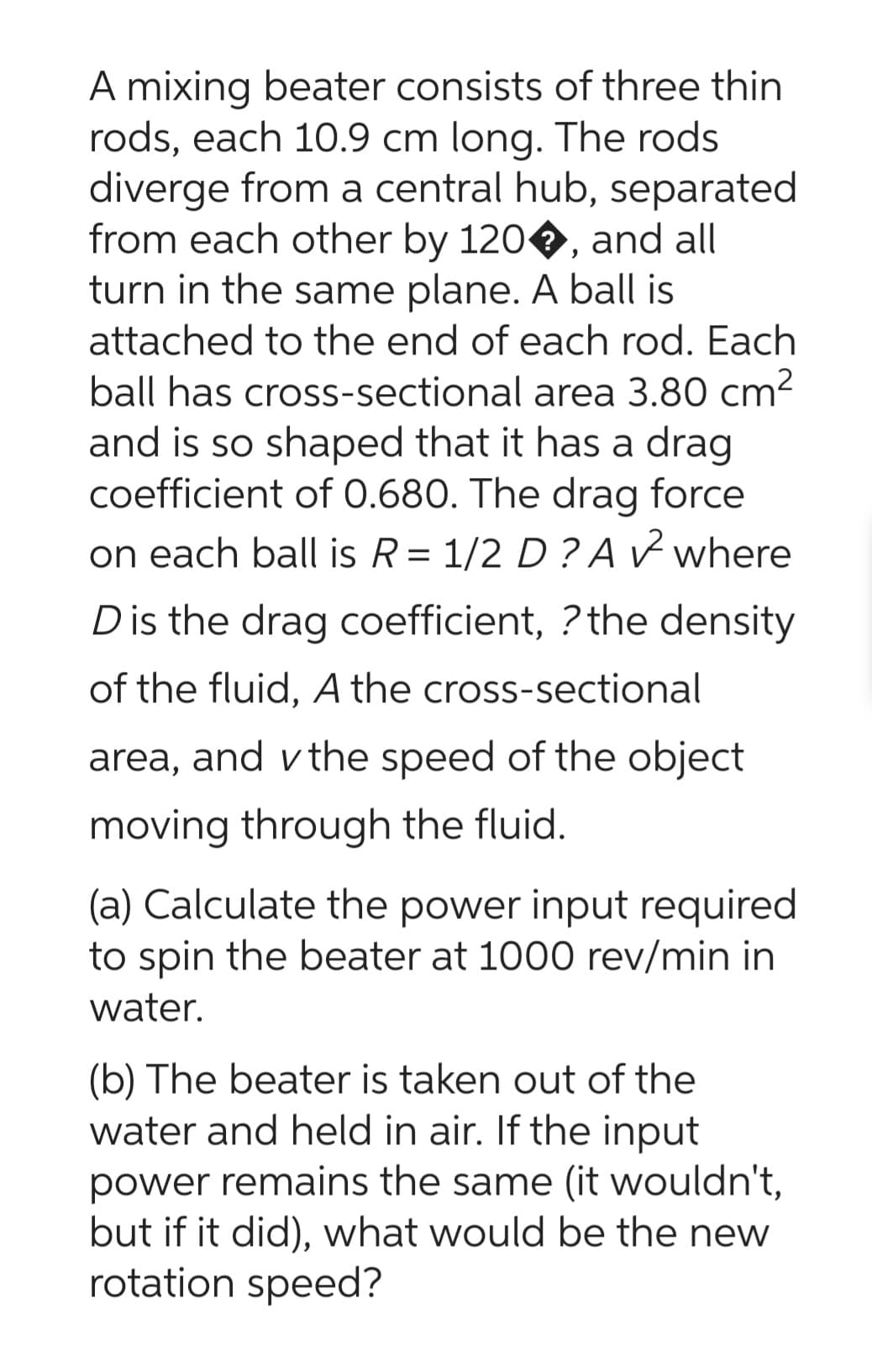A mixing beater consists of three thin rods, each 10.9 cm long. The rods diverge from a central hub, separated from each other by 120, and all turn in the same plane. A ball is attached to the end of each rod. Each ball has cross-sectional area 3.80 cm² and is so shaped that it has a drag coefficient of 0.680. The drag force on each ball is R = 1/2 D? A ✓ where D is the drag coefficient, ? the density of the fluid, A the cross-sectional area, and the speed of the object moving through the fluid. (a) Calculate the power input required to spin the beater at 1000 rev/min in water. (b) The beater is taken out of the water and held in air. If the input power remains the same (it wouldn't, but if it did), what would be the new rotation speed?
A mixing beater consists of three thin rods, each 10.9 cm long. The rods diverge from a central hub, separated from each other by 120, and all turn in the same plane. A ball is attached to the end of each rod. Each ball has cross-sectional area 3.80 cm² and is so shaped that it has a drag coefficient of 0.680. The drag force on each ball is R = 1/2 D? A ✓ where D is the drag coefficient, ? the density of the fluid, A the cross-sectional area, and the speed of the object moving through the fluid. (a) Calculate the power input required to spin the beater at 1000 rev/min in water. (b) The beater is taken out of the water and held in air. If the input power remains the same (it wouldn't, but if it did), what would be the new rotation speed?
Principles of Physics: A Calculus-Based Text
5th Edition
ISBN:9781133104261
Author:Raymond A. Serway, John W. Jewett
Publisher:Raymond A. Serway, John W. Jewett
Chapter10: Rotational Motion
Section: Chapter Questions
Problem 74P: A stepladder of negligible weight is constructed as shown in Figure P10.73, with AC = BC = ℓ. A...
Related questions
Question

Transcribed Image Text:A mixing beater consists of three thin
rods, each 10.9 cm long. The rods
diverge from a central hub, separated
from each other by 120, and all
turn in the same plane. A ball is
attached to the end of each rod. Each
ball has cross-sectional area 3.80 cm²
and is so shaped that it has a drag
coefficient of 0.680. The drag force
on each ball is R = 1/2 D? A ✓ where
D is the drag coefficient, ? the density
of the fluid, A the cross-sectional
area, and the speed of the object
moving through the fluid.
(a) Calculate the power input required
to spin the beater at 1000 rev/min in
water.
(b) The beater is taken out of the
water and held in air. If the input
power remains the same (it wouldn't,
but if it did), what would be the new
rotation speed?
Expert Solution
This question has been solved!
Explore an expertly crafted, step-by-step solution for a thorough understanding of key concepts.
Step by step
Solved in 2 steps with 2 images

Recommended textbooks for you

Principles of Physics: A Calculus-Based Text
Physics
ISBN:
9781133104261
Author:
Raymond A. Serway, John W. Jewett
Publisher:
Cengage Learning

University Physics Volume 1
Physics
ISBN:
9781938168277
Author:
William Moebs, Samuel J. Ling, Jeff Sanny
Publisher:
OpenStax - Rice University

Glencoe Physics: Principles and Problems, Student…
Physics
ISBN:
9780078807213
Author:
Paul W. Zitzewitz
Publisher:
Glencoe/McGraw-Hill

Principles of Physics: A Calculus-Based Text
Physics
ISBN:
9781133104261
Author:
Raymond A. Serway, John W. Jewett
Publisher:
Cengage Learning

University Physics Volume 1
Physics
ISBN:
9781938168277
Author:
William Moebs, Samuel J. Ling, Jeff Sanny
Publisher:
OpenStax - Rice University

Glencoe Physics: Principles and Problems, Student…
Physics
ISBN:
9780078807213
Author:
Paul W. Zitzewitz
Publisher:
Glencoe/McGraw-Hill